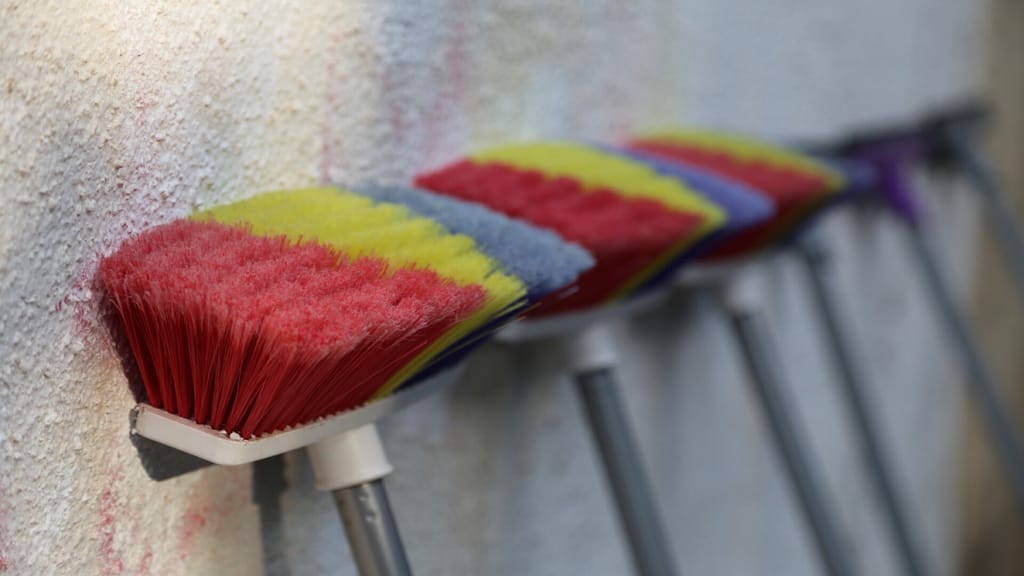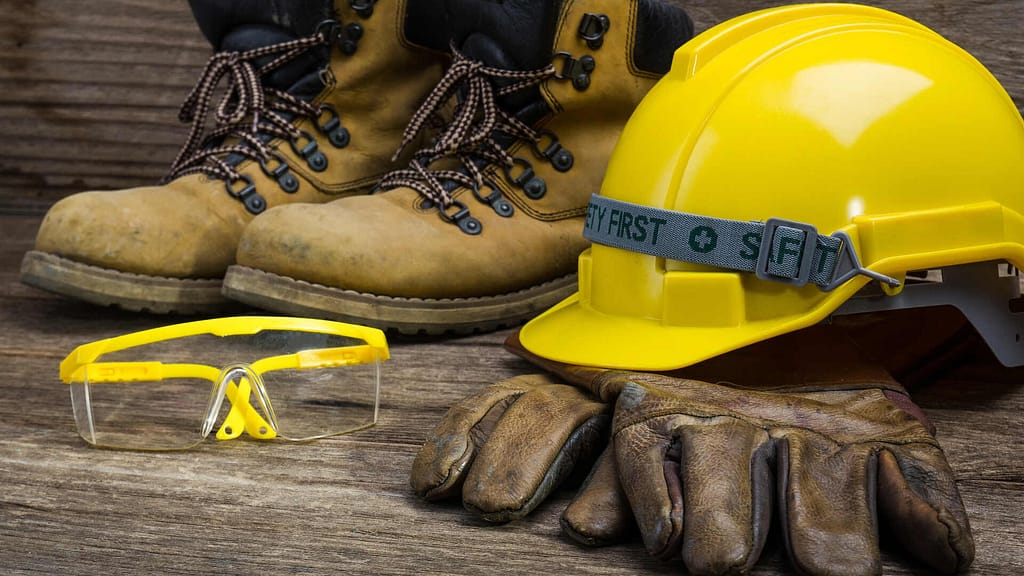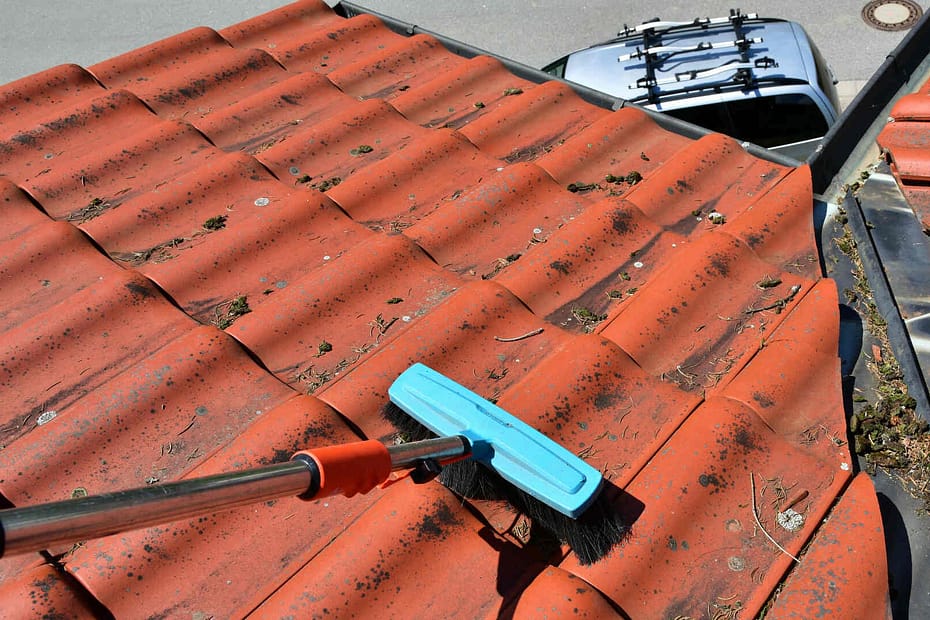How to clean a metal roof? An easy solution is to combine dish soap with warm water in a bucket. Use a soft bristle brush to scrub from the top of the roof toward the ground, repeat with hose.
Table of contents
Safety
Cleaning your metal roof can be very dangerous. We recommend hiring a professional and not doing this yourself. It may seem like a simple task. However, if your metal roof has debris, mold, or foreign bodies on it. It can be extremely dangerous. Adding any liquid to your metal roof will only increase the danger.
If you have to do this yourself, consider consulting with a professional about safety precautions and equipment.
The Importance of Metal Roof Cleaning
Regular roof cleaning prevents damage and keeps a home looking its best. Dirt and moss can harm the roof over time. A clean roof avoids costly repairs and extends its life.

Preventing Rust and Corrosion
One of the leading causes of rust is moisture, especially when it’s trapped between debris and the metal surface. By regularly cleaning your roof, you eliminate layers of leaves, dirt, and other debris that can trap moisture against the metal. This reduces the chance of rust spots forming.
Many metal roofs come with protective coatings designed to resist rust and corrosion. Over time, accumulated dirt and debris can wear down these coatings. Cleaning helps preserve these coatings, ensuring that they can do their job effectively.
Avoiding Mold and Mildew Buildup
Mold and mildew can discolor the metal surface, resulting in dark streaks and patches that tarnish the roof’s appearance. These unsightly blemishes can detract from the overall aesthetic appeal of your home or building.
Cleaning away mold, mildew, and the organic matter that supports their growth ensures the roof retains its structural and aesthetic integrity.
Maintaining the Roof’s Energy Efficiency
A clean, shiny metal surface can reflect a substantial portion of the sun’s rays, reducing heat absorption. Regular cleaning ensures the surface remains highly reflective, maximizing this effect.
When a metal roof can efficiently reflect sunlight, the interior of the building remains cooler, especially during hot summer days. This reduces the strain on air conditioning. We’ve made a post about why metal roofs are better than other types of roofing.
Potential Tools and Supplies You’ll Need
Cleaning Agents (Suitable for Metal Roofs)

- Soap and Water: A simple mixture of mild dish soap and water can be effective for general cleaning. This solution is gentle enough not to damage the metal or its protective coatings. We recommend 1/4 cup of dish soap to 1 gallon of water.
- White Vinegar and Water: For roofs with mildew or mold, a mixture of equal parts white vinegar and water can be used. Vinegar is a natural disinfectant and can help remove fungal growth.
- Baking Soda and Water: A paste made from baking soda and water can be used to treat tough stains or rust spots. Baking soda acts as a mild abrasive that can help remove stains without being too harsh on the metal.
- Commercial Cleaners: There are commercial cleaning products specifically formulated for metal roofs. Look for those labeled as eco-friendly and non-corrosive.
Precautions:
- Avoid using bleach: Although bleach can effectively remove mold and mildew, it can be corrosive to metal over time and may damage the protective coatings. If you must use bleach, ensure it’s heavily diluted and rinsed off thoroughly.
Soft-Bristle Brushes or Brooms

Utilizing a soft bristle brush or broom is recommended for cleaning metal roofs, especially those with protective coatings. These brushes ensure the effective removal of debris and dirt without compromising the roof’s paint or finish.
When choosing a brush or broom for your metal roof, it’s essential to pick one with non-abrasive and non-metallic bristles to ensure the metal and its coating aren’t scratched or damaged.
Pressure Washer on low setting

Pressure washers are gauged by the amount of pressure they exert, measured in pounds per square inch (PSI). For cleaning sensitive areas like metal roofs, a low-pressure washer, typically ranging from 500 to 2000 PSI, is ideal. This range ensures effective cleaning without causing harm to the roof’s coatings or surface.
Pressure washers come with various nozzle tips that determine the angle of the water spray. For metal roofs, wider angles (such as 40°) are preferable as they spread out the force, minimizing potential damage.
Protective Gear

Cleaning a metal roof, like any elevated or potentially slippery work, requires the appropriate protective gear to ensure the safety of the individual undertaking the task.
- Safety Harness: Especially crucial for steeply pitched roofs, a safety harness can prevent serious injuries in case of slips or falls.
- Roofing Boots or Non-Slip Footwear: Shoes with soft rubber soles that offer a good grip are essential.
- Protective Gloves: Durable waterproof gloves can protect your hands from chemicals, ensuring you also maintain a good grip on tools.
- Safety Glasses or Goggles: These will protect your eyes from potential splashes of cleaning solutions or any debris.
- Wide-brimmed Hat or Cap: This will provide additional protection against the sun, especially if working during peak sunlight hours.
Durable Ladder

A ladder’s stability is paramount when working on or around roofs. The wrong ladder can pose significant risks, from slipping on the rungs to the ladder itself collapsing or sliding off the roof’s edge. Before each use, inspect your ladder for any signs of wear, damage, or defects.
Buddy System
Like any dangerous activity we recommend you use the buddy system. Have someone to help you. Hold the ladder, keep an eye on you. If you live alone, tell a neighbor that you’ll be working on the roof and can they keep an eye for you. This simple step could save your life.
Comprehensive Procedure for Metal Roof Cleaning

Regular cleaning prevents the accumulation of dirt, debris, and organic growths which can diminish the roof’s performance over time. Here’s a detailed guide to help you navigate the process.
Preliminary Inspection
Before starting, conduct a thorough inspection to identify any damaged areas, loose panels, or potential issues.
Ensure gutters and downspouts are clear of debris, which can prevent proper water drainage.
Dry Sweeping
Using a soft-bristle broom, gently sweep off any loose debris such as leaves, twigs, or dirt.
Prepare Cleaning Solution
Mix a solution of water and a gentle detergent. Commercially available roof cleaning agents can also be used, but always read and follow the manufacturer’s guidelines. Avoid harsh chemicals that can corrode or damage the metal surface.
Gentle Washing
With a soft-bristle brush or scrub, gently scrub the roof’s surface. Always work in sections, starting from the top and working your way down to prevent dirty water from flowing onto cleaned areas. If using a low-pressure washer, ensure it’s set to a gentle setting to avoid damaging the roof or its coating.
Address Stubborn Stains
For mold, mildew, or other stubborn stains, consider using a mixture of equal parts water and white vinegar. Commercially available roof cleaning agents can also be used. Test a small area first to ensure it doesn’t discolor or damage the metal.
Rinsing
Thoroughly rinse off the cleaning solution using a hose with a gentle spray setting or a low-pressure washer.
Ensure all residue is washed away, as leftover cleaning agents can harm the roof’s surface over time.
Post-Cleaning Inspection
Once the roof is clean and dry, conduct another inspection to identify any areas that might need further attention or repair.
Regular Maintenance
Establish a regular cleaning routine, at least twice a year or after major storms, to ensure your metal roof remains in optimal condition.
Potential Risks and When to Call a Professional
While cleaning your roof yourself has benefits, you might accidentally reveal or cause small damages like scratches. If left unattended, these can grow into bigger problems like leaks or rust. If things seem too far gone or if you think your roof needs replacement, don’t hesitate to consult with a professional roofer for a detailed assessment and guidance.
Conclusion
If after cleaning your metal roof you see serious signs of damage it may be time to replace your roof. Keep in mind that a metal roof has a very long lifespan. But if your roof is showing signs it maybe time to get an estimate for a new metal roof via our free metal roof cost calculator.
Cleaning a metal roof is not just about making it look nice. It’s a key step in keeping the roof strong and working right. Regular cleaning helps avoid problems like rust, mold, and less energy-saving. While this guide gives you tips to clean the roof yourself, don’t forget that you can always call experts if you need help or have tough problems. When you keep your roof clean, it will last a long time and work well for you.
Fact checked by Jacob Petrosky – 9/7/23
